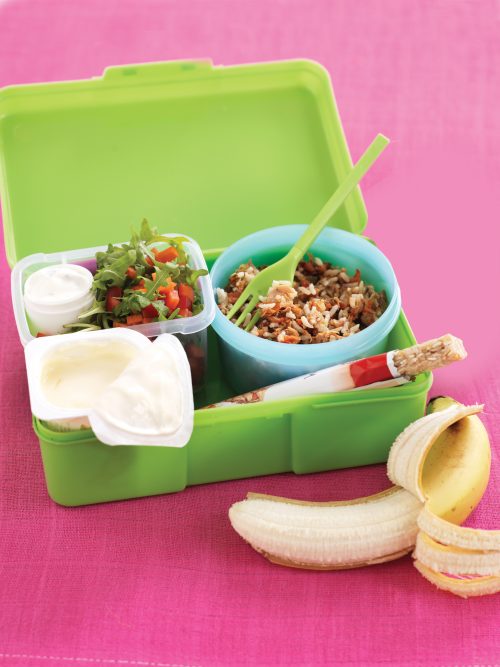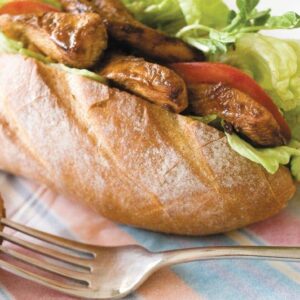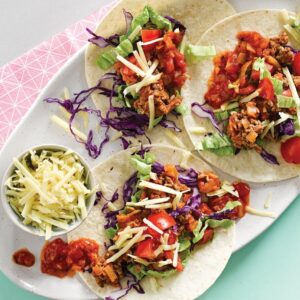
The five nutrition musts for creating healthy, balanced, easy (and most importantly, tasty!) lunchboxes for little kids and big kids alike.
1. High-fibre wholegrain carbohydrates
Reduce the chances of sandwiches returning home untouched: keep bread and fillings interesting. While it’s important to choose high-fibre and wholegrain varieties, taste and texture are important, too. Try mixing it up by using wraps, flatbreads, pita pockets, grainy rolls and crisp breads (and high-fibre white loaves if they really won’t eat anything but the white stuff).
2. Protein
Some meat, cheese or other protein is an essential part of any lunch to help with sustained satisfaction. Protein-rich food also has important essential nutrients such as calcium, magnesium, iron and omega-3 fats. Add sliced cold meats or canned tuna to wraps or sandwiches, hard-boiled eggs and reduced-fat dairy (cheese sticks, cheese slices on a roll, flavoured milk or yoghurt).
3. Vegetables and fruit
While they may not be every kid’s favourites, vegetables and fruit are essential components of a healthy lunchbox. They provide filling fibre and important vitamins and minerals without adding too many kilojoules.
To add vegetables to lunches, grate or use a vegetable peeler to shave fine slices of carrot or cucumber into sandwich fillings. Add shredded lettuce to sandwiches for extra crunch. Or pop in vege sticks as ‘bits’ to pick at or to use with dips. Or mix together leftover roasted meat and veges (eg. cold roasted pumpkin) from the night before and mix with fresh salad ingredients such as baby spinach and cherry tomatoes for a simple, filling lunch.
Single pieces of fruit are a quick and easy lunchbox item. If there’s resistance to eating fruit whole, get creative: peel and core an apple and slice it into rings or quarters (sprinkle with lemon juice to keep it from going brown). Or add fruit which naturally comes in bite-sized pieces — for example, grapes or blueberries. Stone fruit, when it’s season, makes a delicious treat. Or alternate fresh fruit with dried fruit and fruit tubs.
4. Snacks
Growing kids need to have something to eat every few hours — healthy mid-morning and afternoon snacks boost their energy and also brain power. Ideal snacks for kids include fresh fruit or reduced-fat dairy. Packaged snacks can help with variety and boost their intake of some essential nutrients. Try to stick to just one packaged snack per day if you can, as they can also add lots of sugar and salt without you realising.
For healthiest choices look for snacks that, per serve, have less than 600kJ, 3-5g protein and contain whole grains, calcium and/or are low-GI. These will deliver the most vitamins and minerals and give kids the longest lasting energy.
5. Fluids
Fruit juice and soft drinks are easy lunchbox additions but it’s best to use these occasionally. Sugary drinks add extra kilojoules without filling tummies, and they have been shown to contribute to tooth decay. Water is always the best choice. ‘Dress’ water up if kids need encouragement to drink it: use a snazzy drink bottle, try adding a dash of cordial and slowly reduce the amount of cordial you add as kids get used to it. For older kids add a few mint sprigs and a slice of lemon or lime. To mix it up, try a small no-added-sugar fruit juice or a fruit and vege juice blend occasionally.
How much do kids need?
To help kids grow properly, develop strong bones and perform well at school, it is important that they get the nutrients they need from the food they eat. Eating a wide variety of foods from the five food groups is key. While the recommended dietary intake (RDI) varies from child to child, and also depends on their activity levels, we’ve tried to make it easy by listing the RDI specific to kids’ age range and gender.
| 4-8 years (boys & girls) |
9-13 years (boys) |
9-13 years (girls) |
14-18 years (boys) |
14-18 years (girls) |
|
| Weight (kg) | 16-26 | 29-46 | 29-56 | 51-67 | 49-56 |
| Height (m) | 1.01-1.28 | 1.34-1.56 | 1.33-1.57 | 1.64-1.76 | 1.60-1.63 |
| Energy* (kJ) | 4800-8200 | 6800-11200 | 6400-10000 | 9300-14000 | 8100-10900 |
| Protein (g) | 20 | 40 | 35 | 65 | 45 |
| Sat fat (g) | Limit | Limit | Limit | Limit | Limit |
| Fibre (g) | 18 | 24 | 20 | 28 | 22 |
| Sodium* (mg) | 300-600 | 400-800 | 400-800 | 460-920 | 460-920 |
| Iron (mg) | 10 | 8 | 8 | 11 | 15 |
| Calcium (mg) | 700 | 1000-1300 | 1000-1300 | 1300 | 1300 |
*Adequate intake
Note: There are no specific recommendations by age for carbohydrates and total fat.
Source: Ministry of Health. 2006. Nutrient reference values for Australia and New Zealand: Including Recommended Dietary Intakes. Canberra, Commonwealth of Australia
Healthy lunchbox ideas
Here are some lunchbox ideas to get you started. Remember to include a frozen bottle of water!
Lunch
Tuna and rice salad with vegetable side salad and tzatziki
Snacks
- Pottle of low-fat yoghurt
- Banana
- Muesli bar
- Fruit and vege juice (frozen)
- Frozen bottle of water
Lunch
Pita pieces, vegetable sticks and cherry tomatoes with hummus and light cream cheese
Snacks
- Hard-boiled egg (smiley face optional)
- 4 mini pikelets with 1 teaspoon jam on each (as an occasional treat)
- Piece of fresh fruit
- 250ml pack Calci Yum milk
- Frozen bottle of water
Lunch
4 Vita-Weat crackers, vegetable sticks and reduced-fat cheese plus small container with hummus
Snacks
- High-fibre fruit mini-muffin
- Piece of fresh fruit
- Frozen bottle of water
Lunch
Tuna, reduced-fat mayo, corn and lettuce filling in mini wholemeal pita bread
Snacks
- No-added-sugar peaches fruit tub OR piece of fresh fruit
- Muesli bar
- 250ml pack Calci Yum milk
- Frozen bottle of water
Lunch
Mince ‘burrito’: pack leftover Bolognese, salad and reduced-fat cheese in separate containers for kids to wrap at school in a wholegrain tortilla (to prevent a soggy lunch)
Snacks
- Muesli bar
- Pottle of low-fat yoghurt
- Piece of fresh fruit
- Frozen bottle of water
Lunch
Sandwich with sliced roast beef, lettuce, tomato and cucumber on grainy bread
Snacks
- Pottle of low-fat yoghurt
- 4 Vita-Weat crackers with Vegemite or Marmite
- Piece of fresh fruit
- Frozen bottle of water
Lunch
Chicken, cherry tomato, lettuce and feta cheese pasta salad
Snacks
- 2 reduced-fat cheese and Vegemite or Marmite Ryvita sandwiches
- Fresh fruit salad
- Frozen bottle of water
Lunch
Meatballs in mini wholemeal pita pocket with lettuce, grated carrot and reduced-fat cheese
Snacks
- Celery and light cream cheese ‘boats’
- No-added-sugar fruit tub
- Fruit Stick
- Frozen bottle of water
www.healthyfood.com










